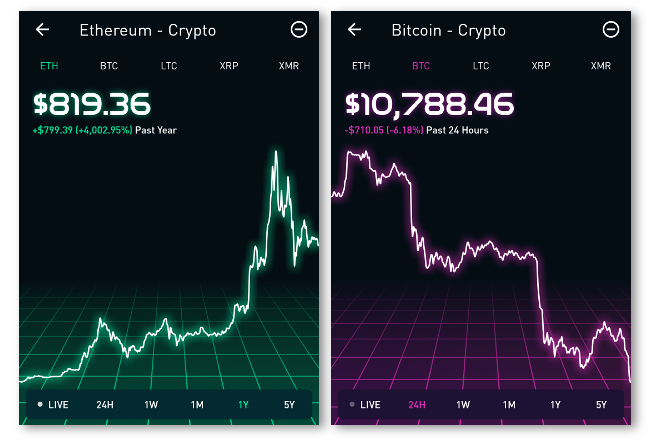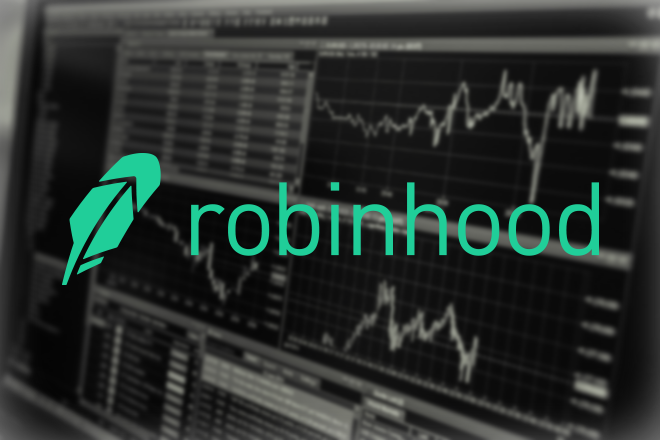It may sound cryptic, maybe even a little ominous, but that short phrase generated a lot of buzz for Robinhood’s cryptocurrency announcement. Over 1.25 million people joined the waiting list in less than 24 hours, drawn by the service’s mix of stock offerings, mobile apps, instant deposits, and biggest of all, no-fee trades.
The real power of Robinhood lies in its accessibility. Buying and selling cryptocurrencies normally requires a willingness to research good security practices and navigate complex exchange dashboards. Robinhood strips those out in favor of a well-designed UI and two-click buying and selling.
Robinhood’s foray into the cryptocurrency space could be huge. It’s the perfect springboard for casual audiences to dip their toes into the cryptocurrency scene. If the team can keep this impressive momentum going, it could be the first real competitor to Coinbase.
The Basics of Robinhood
Robinhood started as a stock trading service with two simple goals: eliminate fees through automation, and lower the barriers of entry so more people can buy and sell stocks. The 2018 push into cryptocurrencies doesn’t change those guiding principles, it simply adds them to the interface.
In 2013, co-founders Vlad Tenev and Baiju Bhatt pitched the idea of Robinhood to 75 different investors, all of whom said, “No thanks.” The pair soldiered on and eventually found success, netting over 1 million pre-launch sign-ups and attracting investors like Netscape co-founder Marc Andreessen. Snoop Dogg even backed the project in its early stages, showing just how attractive Robinhood is to the non-tech sector.
As of April 2017, Robinhood was valued at over $1.3 billion and has handled more than $30 billion in trades.
Robinhood’s push into the cryptocurrency market space was announced late January 2018. They were immediately overwhelmed with interested traders, building a waitlist of over 1,250,000 e-mail addresses by the end of the day. This is despite limited regional availability (it’s currently only available in California, Massachusetts, Missouri, Montana, and New Hampshire) and a restriction to just fiat-to-BTC/ETH trades.
Using Robinhood
Robinhood is so straightforward your grandmother could use it. Account creation takes just a few minutes and only requires contact information and a valid Social Security number (no scanned passports or other forms of ID). You’ll then add up to 16 cryptocurrencies to your watchlist and enter bank account details to link Robinhood to fiat. Once this has been verified, you can send a deposit and start buying cryptos or stocks immediately.

Robinhood’s interface is structured around charts. The watchlist shows up on the home screen, with portfolio information and your available funds at the top. You can examine individual stocks or cryptocurrencies with a quick tap. No candlestick charts, just line graphs showing data for a day, a week, a month, a year, or five years.
Buying and selling stocks takes just a few taps. Choose something from your watchlist, tap “buy”, enter the number of shares, confirm, then celebrate with confetti. Selling happens in much the same way, taking a lot of the guesswork out of the process so you can get to the good stuff.
At the time of writing, buying and selling cryptocurrencies on Robinhood is limited to Bitcoin and Ethereum. It’s also only available in five U.S. states, and only to people on the waitlist who have received their invite. More states and wider available are planned for the future.
Money In, Money Out: Drawbacks to Using Robinhood
One of the biggest drawbacks to the Robinhood experience is the inability to transfer cryptocurrencies in or out of the service. It’s a closed fiat-based model with no coin wallet addresses or anything like that. Withdrawals will be supported in the future, but for now, what you fund on Robinhood stays on Robinhood.
Trading availability is another frustrating restriction. Access is severely limited based on location and invitation, but even if you do get the go-ahead, you can only trade in BTC and ETH. That’ll be fine for casual users, but most users will want to branch out beyond the big two at some point.
Both of the above drawbacks could be deal-killers for experienced crypto traders. They help provide a more secure experience for mainstream adopters, however. There’s no need to worry about seed phrases, no wallet addresses to swap. All you can do is what most newcomers are interested in doing: buy cryptocurrencies, hold for a few months, then sell to make a profit.
One hidden drawback to the Robinhood experience is it threatens to raise a crop of new crypto traders who can’t move beyond the platform. Solving the problem of cryptocurrency accessibility doesn’t mean ignoring it. New users who decide to step beyond Robinhood will be just as confused as before, leading to bad investment decisions or lost funds due to human error. The legions of users who joined Robinhood will simply be fans of Robinhood, not cryptocurrencies in general.
Robinhood’s Future
Robinhood is primed to throw open the doors for mainstream traders. All of the right ingredients are there, and the enticement of no-fee trading should convert doubters lingering in the corner. In a lot of ways, it’s more of a killer app than Coinbase.
Jumping into cryptocurrencies is one thing, but growing beyond the basics is another. Robinhood doesn’t offer any educational tools for new users, nor will its closed ecosystem help with mass adoption of cryptocurrencies in general. That could be a net negative for the ecosystem.
Robinhood has a large, well-established collection of users. Convince them of the earnings potential in cryptocurrency, bring in new mainstream customers, then cap it off with better transaction support and new buying pairs. If those elements fall into place at just the right time, Robinhood could turn out to be a serious disruptive influence.
Related: Beginner’s Guide to Buying Bitcoin

